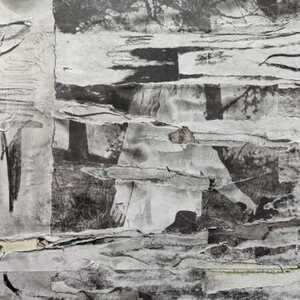
Apichatpong Weerasethakul
by Lily and Generoso Fierro

As part of his recent week-long visit to Los Angeles sponsored by the Los Angeles Filmforum, Film at REDCAT, and CalArts Film/Video, during which he taught classes and screened his globally acclaimed features at The Cinefamily and the Aero Theatre, director Apichatpong Weerasethakul visited the Billy Wilder Theater at the UCLA Film and Television Archive to take part in a two-night complete retrospective of his rarely screened short films. These appearances by Weerasethakul had long been circled on our calendars (and those of many others who attended the sold-out screenings) as we have joyously followed his career since seeing his exceptional 2004 Cannes Jury Prize winning film, Tropical Malady.
We were thrilled to have an opportunity to sit down with Weerasethakul for a short interview that turned into a fascinating and sometimes bizarre ninety minute discussion about everything from his filmography to the beauty and ugliness of Buddhism to censorship issues in pre- and post-military coup Thailand to the failure of media to represent innovations in science. Weerasethakul has exceptional sensibilities in capturing the many layers of reality around him, and for that reason his films and his conversations with us and the audiences who attended any of his screenings are engaging, giving, and outstandingly thought-provoking.
Q: LF: One of the things I’ve loved about your films is that they are films of contrast. And this is especially true for Uncle Boonmee Who Can Recall His Past Lives and Syndromes and a Century, where you have very different characters, time periods, ghosts, and problems in and outside of the city. Could you speak about how you get inspired by the city and the places outside of it and how the two can exist in the same space even though they are so different?
A: AW: I grew up in a small town that now is big, so I’ve seen really rapid change all over Thailand and also Asia over the past 30 to 40 years. Also, these contrasts are even clearer because there’s this feeling in Thailand that everything is always part of a very centralized culture that revolves around Bangkok. So, I have had this feeling that I don’t like the city of Bangkok, and that lasted until now. When I started in movies, I tried to avoid Bangkok, and I just traveled around. And then with my next film, Tropical Malady, I was in the jungle in a small town, and with that, I was really interested in the contrast because even though the movie is staying in place, the emotion is shifting from the beginning, which starts very pleasantly, to the end, where even the same environment, the same sounds of birds become very oppressive, very heavy So, I think it kind of shifts, and also when shooting in the jungle, you see the shadow and the sun, and when you are waiting for something or when you are preparing during the day and night, you see different characters of nature, so that’s why I decided to make Tropical Malady about this difference between darkness and light, present and past.
Q: LF: As a practicing Buddhist, I must say that you perfectly capture the conflicts and difficulties with living with the belief system in society, past or present. Here, in the West, it is rare to see the complexities of Buddhism on the big screen, and your films always have a Buddhist influence. For example, many of your films mention the merit system at one point or another, especially when a monk appears. Could you talk about how you look at Buddhism and how you integrate your perspective and thoughts on it into your films?
A: AW: In fact, I’m quite fascinated by the karmic law that we believe. And, it’s so hard to shake it off, especially when you were young and raised with those ideas, and I just feel that it’s a curse. I really feel that karmic law is so, in this century in a third world country, prone to abuse politically, and so people become quite passive. For example, they would say, “This is our faith. This guy gained good merit before, so he deserves to be that and that.” It creates a strong hierarchy system in Thailand, so that and also the awakening of the country’s narrative through different media and the internet over the years makes you start to feel that there was a lot of propaganda around when you were growing up. The identity of the country is kind of shaking, so with the history, politics, and religion, it placed Thailand onto a very dangerous path now, I think. For me, we have so many rituals dealing with Buddhism from Hindu influence, and I think that is a big problem, to install something so physical into these beliefs, and so over the years, I was less and less interested in the ritual and more into what to present from karmic law. It is so fascinating; it’s just so beautiful and ugly at the same time, this manifestation of the merit system. I’m also quite interested in the meditation parts and how Buddhist philosophy is so scientific.
Q: LF: Yes, there are the cosmic planes! I really appreciate your description of the implementation of the merit system as “beautiful and ugly” because as someone born into the faith system in America, I always saw this in the temples here, and it is something I always struggled with, and it is why your films mean so much to me because they capture this paradox between the faith and the way it is practiced.
A: AW: It shows in daily life, and so for me when I make film, sometimes I add just a little jab, or sometimes I am just inspired by these actions of myself and people.
Q: LF: Was this conflict of Buddhism in daily life something you noticed and had a discourse on before you went to America, or did you notice it more after your time at the School of the Art Institute of Chicago?
A: AW: After. After. Before, when I studied architecture in Thailand, let’s say, I still believed in reincarnation. Even the first few years after going back home, I still believed, but now, I don’t. I just feel that it’s such a waste of time, and also it doesn’t really make people see the beauty of life actually, of just living. Instead of opening their eyes, they always think about the future; they always think about just going to the temple. Physically, you know, it is beautiful; it is exotic, but in fact, there’s a trap, and I feel that is the wrong path of Buddhism in Thailand.
Q: LF: It makes sense that Buddhism has led to passiveness because you’re always thinking about the next life, and you think to yourself, “I’ll get to that in the next life,” so you don’t do it in this one. Do you think this passiveness of people caused by Buddhism integrated into society is going to change after King Adulyadej’s passing?
A: AW: No, I think it might get worse because the King’s passing is prone to manipulation by the current government. The situation is already showing on the street. How this situation has been used to make people feel together is a good thing, of course, but at the same time, it can justify certain evil from the government. I never approved of the army government that used weapons to create fear in people and silence critics, so with this collective mourning time, people are really fragile, so they can follow things so easily, so I am very worried about that.
Q: LF: Now that I think about it, you always include military figures or monks in all of your films. Is that because you see the military and monks regularly when you live in a town, or is it that they are supposed to be symbolic representations of forces at play in Thai society?
A: AW: Oh, did I? Not really for the monks. For the military, yes. But for monks, I did not consciously put them in because you can see them so easily in the street. For military, yes, it’s the role I’ve seen them take over the years to be more and more repressive figures.
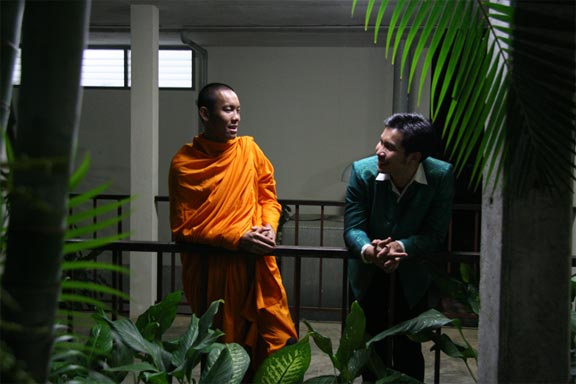
Q: GF: During the Q&A session from last night here at UCLA, you said that Syndromes and a Century was censored by the Thai government. I can see the issue that the post-military coup government might have with Cemetery of Splendor, but it’s unclear to me as to what issue the previous government had with Syndromes and a Century.
A: AW: It was not really a military time–we had a normal government then. They objected to moral issues because Thailand is super conservative, even though we have so many vices, but they just think of film as something that does not represent reality; it should serve some purpose. That’s why films in Thailand have a lot of fantasy, ghosts, or martial arts. With a film that is reflecting life and being done in such a natural way, they were alarmed about things like the doctors drinking, or the monk playing guitar, or the monk playing with the UFO toy, even though in real life, you see a lot worse. So, they really asked me to cut these moments out. At the time, the police department was taking care of film censorship, and they invited different people from different organizations that were linked to the film’s content, meaning that they invited people from a doctor’s association, a Buddhist group, and a journalist association along with a film scholar too to meet with a policeman around this round table, and I wasn’t allowed to enter the discussion until later when they decided, “We have #1, this scene, this scene.” And then, each one started to say, “Why don’t you make a film that shows doctors helping patients in surgery? Why don’t you make a film that shows the monks being good?” It was a really backwards way of thinking of film as propaganda that has to serve certain things. That was 2007; it was not 100 years ago, and the scary thing is that many people have this mentality until now, a majority of people, more than half, I’m sure. I was really angry, of course, and the film teacher from the university said, “Hey Apichatpong, you should stop making film. You should go back to school and learn how to make movies again.” That was really hurtful, but anyway, I just got out of that session, and I started the campaign for the Free Thai Cinema movement. We had protests, and we went to Parliament to try to change this law; it was an archaic law that had been around for a long time. And then, the censorship role shifted from the police to the ministry of culture, and so they have a rating system now, better but still a little backwards, but better than before.
Q: GF: With Tropical Malady and any other time when you address homosexuality in your films, have the censors drawn issues with that?
A: AW: Not really. Now, somehow, homosexuality has been in the media for quite a long time. We have a very popular series about this teenager’s love, and it really is accepted. Thailand is one of those very odd countries in terms of human rights; there are many problems, but at the same time, people are very accepting of gay issues. It’s really common to see two men or two women holding hands. When you go to a 7-11, sometimes the people behind the counter are transvestites; this is really common. Transexuals also are often flight attendants. Sexuality is quite fluid in Thailand. I live with my boyfriend in a small village in a remote area, and people are very friendly and so accepting.
Q: LF: We’re glad to hear that. Southeast Asia is still so conservative politically and socially, so it is fascinating that somehow, Thailand is at least somewhat progressive on issues surrounding sexuality.
A: AW: Thailand is still really xenophobic, but gay issues are okay somehow.
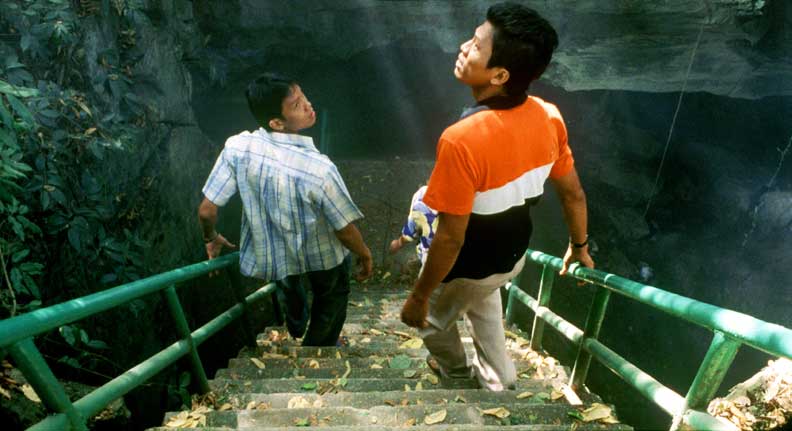
Q: GF: While Uncle Boonmee Who Can Recall His Past Lives has been often described as dream-like, I always thought of it more as an experiment of imagination because I’ve always wondered what forms people will take once they have passed away. How did you determine what form each of Boonmee’s visitors would take?
A: AW: Oh, the forms came up from my memories of media because Boonmee is a tribute to things that I love: old television, old royal costume drama, old horror movies. Actually, Boonmee has six reels; it’s the film that I knew would be my last film shot on celluloid, and it was, so I divided it into the film system because when you show the film, each 35mm can holds about 20 minutes max, so for me, the film has six reels, and each reel has a different representation. The audience might not notice because it creates one storyline, but if you look at each reel, there is some different shift in color, different shift in lighting, and even the acting style, which sometimes is really realistic or sometimes really stiff like old TV. And one reel is a royal costume drama, the one with the princess. And the jungle in the last reel is my old adventure tales memory. Compared to the jungle in Tropical Malady, which is almost like a realistic jungle, the jungle for Uncle Boonmee is a jungle of media, so it has this day for night shooting, so there’s a really artificial blue tint for the jungle. This is why I introduce this film as a collection of memories.
Q: GF: In many of your conversations during your screenings this past week, you have mentioned your love for old science fiction. You have spoken of making a film called Utopia, which you originally said had a setting of the Starship Enterprise and would include notable science fiction film leading ladies like Jane Fonda from Barbarella. We have been hoping to hear word of you filming this. We love old science fiction, and this premise is too alluring. Is there any chance it will ever happen?
A: AW: I think it’s very hard because I think I need to rewrite a lot of that. Because for me when I do projects, it is always about, like Mekong Hotel, which is showing now, revisiting old ideas but then changing it because it represents myself; not me, I mean, I’m not the person in the past called “Apichatpong,” and now, everything feels really distanced very quickly for me, so Utopia needs to be rewritten, but of course, if someone gives me the money, of course I would love to do it. It’s quite universal, and it’s really relevant now actually. I don’t know why I wrote that originally, but Utopia is all about violence in nature. The whole film is about the collapsing of the landscape in North America. Not in the city, but in the snow mountains and in all of these places. It’s almost like a very violent nature.
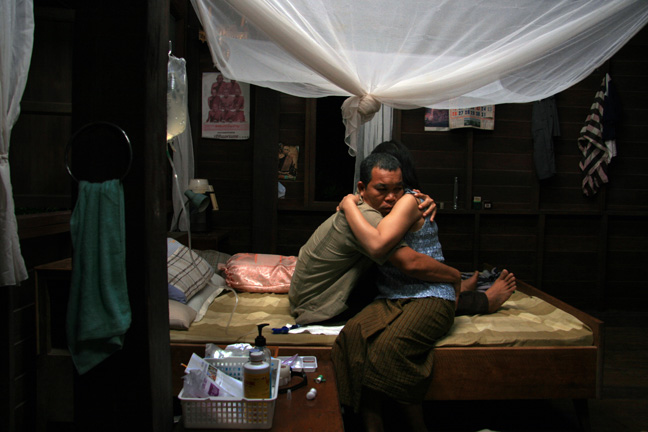
Q: GF: Your regular cinematographer, Sayombhu Mukdeeprom, was stolen from you by Miguel Gomes for Arabian Nights, leading to him spending more time in Portugal than expected, which prevented him from being able to film Cemetery of Splendor. When you and Sayombhu work together, how much do you influence each other’s vision because you can definitely see elements of your style in Arabian Nights and Cemetery of Splendor has a different look in its use of artificial lighting and color?
A: AW: Yes, Sayombhu was stolen. With Sayombhu, it went back to Blissfully Yours. That was his first feature film, and he used to only work in advertising, but he really understands me; he’s one of the very few DPs who understands what’s the difference between advertising and cinema in terms of image, and he also studied at a Russian film school under the DP of Tarkovsky, so he has quite an eye and a philosophy of cinema, so we got along very well from the first film. And so he influenced me a lot, and also, he knows me and my preferences. It is the same with my editor and sound designer.
Q: GF: You develop that personal relationship. We saw Leos Carax speak about his cinematographer who recently passed away. Though the two weren’t great friends, they ate breakfast together nearly everyday, and that’s not something you can easily replace. I can imagine that it was strange when Sayombhu was stolen. Did you get a chance to see Arabian Nights yet?
A: AW: Unfortunately no. It was at Cannes, and I was just too busy.
Q: GF: It is a magnificent film. If it is a consolation, you lost Sayombhu, but he did phenomenal work on Arabian Nights.
Q: LF: Cemetery of Splendor was filmed by Diego García who came recommended from Carlos Reygadas, a director whose sensibilities are not too far from yours. You have said that Cemetery of Splendor is most likely your last film shot in Thailand, and in last night’s Q&A, you mentioned that Latin America may be your next destination. Did working with García and/or speaking with Reygadas point you even closer to Latin America?
A: AW: Exactly. Not only Carlos, but also just being there in Mexico City because I have a gallery there that I work with for visual art, so I went there quite a number of times, and I think my draw to Mexico is because it is actually the reflection of Thailand because it’s so comparable. Something like Tropical Malady or other Thai myths and jungle stories that I liked were written in the ’60s and ’70s, and they were actually influenced by the American or European writers that went to South America to create stories about these adventures and animals during colonial times, and they wrote, really, about a romanticized jungle. So actually, for me, there’s a trace of this influence to make me interested in the allure of the jungle, so I think maybe going to South America is like going back to the source to this thing. I was in Peru, and it was like going home somehow. I don’t know why. To see the ruins and the technology of the past is almost like science fiction to me but reversed in time.
Q: GF: When you see a Mayan temple, it really does feel as though you are entering a science fiction film. South America has become so fruitful in its cinema too–the new movements in Chilean and Argentinian cinema are just two of the scenes that are thriving, so it would be a wonderful place for you.
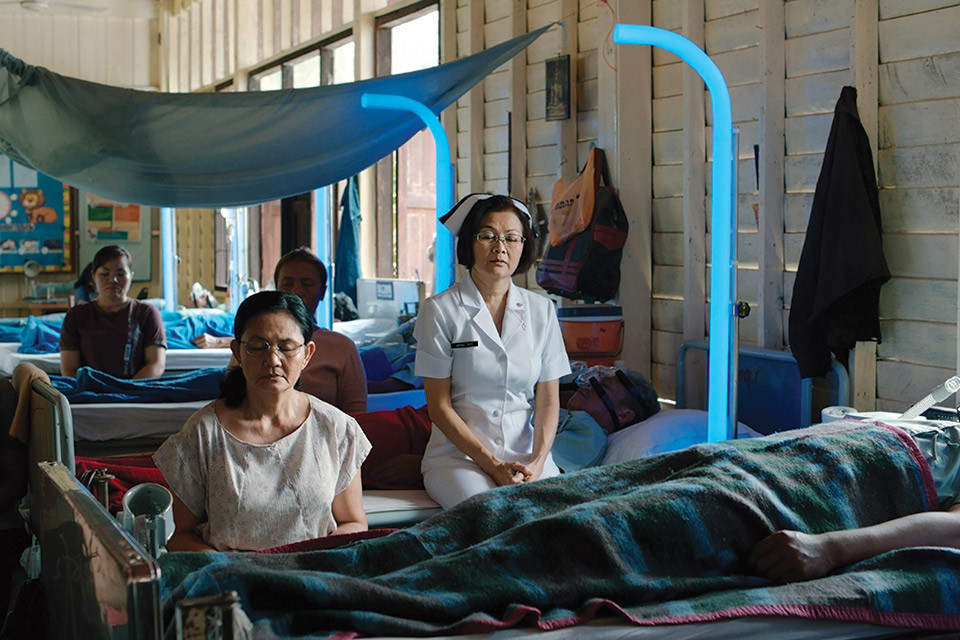
Q: LF: Science is clearly something you love; it always has a visual influence in your films, and it also has a thematic role too. In Syndromes and a Century, science has a very interesting role in the way that it impacts our daily relationships. How much of your interpretation of science, its applications to the past and present and how it can make people more separated from each other even though it can help make life better, goes into your films?
A: AW: For me, science is like art. For me, they are very inter-woven. In Cemetery of Splendor, it is really about perception, and how our brain works and how loneliness can trigger something, and how dreams can manifest desire and imagination. I don’t know; it’s hard to explain, but it’s all these inner-workings when we sleep or when we dream that I am interested in, and I did quite a lot of research and tried to present it in the film–how some logic seems to be in our dreams, how some logic seems to be okay even though it seems so outlandish sometimes. So, this representation of dream is very interesting to me. It’s not like when you dream in let’s say mainstream cinema, sometimes you can see something like a Salvador Dalí painting, things melting or something like that, but for me dreams are really so ordinary, but there is some little chip of logic in them.
Q: LF: And, that’s why you have the different colors of light in the hospital, right? I read that you had been interested in how colors can modulate brain activity?
A: AW: Yeah, there is really amazing research about how colors can trigger false memories in mice; it can introduce information there. I think maybe we already do that with film. When you look at cinema or media it’s already there, you know, you just put information in people. For me, the sleeping soldiers and all this shifting light maybe are about just putting all this narrative into their dreams. It’s like education; it’s like how we grow up: what we are told and how we are being lied to about different pasts.
Q: GF: You had mentioned in a Q&A after the first night of short films that you were a big fan of Gattaca, so much so that it was part of one of the listening exercises that you conducted with students at CalArts this week to get them to be more aware of sound. Gattaca was so underappreciated here because I think that when most Americans think of science fiction, they think of Star Wars and that type of science fiction film. Gattaca is a very intelligently made film; I wish Hollywood would look at science fiction less as action cinema and more as an opportunity to operate a narrative in a genre that is so expansive; you can do so much with science fiction, but for the most part, it always turns into Guardians of the Galaxy. And, it doesn’t have to be that.
Q: LF: And science in and of itself, has smaller things happening than space travel that are fascinating, and you can explore them in film. For example, we’ve seen research where microelectrodes can be implanted into a mouse’s brain, and a radio can be used to control their movements. There’s also active research about the neural encoding activity of birds as they learn how to form their own birdsongs. There are a lot of strange and amazing things happening in science that would be great platforms for science fiction, but I don’t think they will get used.
A: AW: I love Gattaca. This country is so big that the progress of science is so fascinating, the research. But at the same time, it is not reflected in the media, in popular media, so it seems like it is not really well synchronized. It should, no? Media should reflect the humanity of these times, so scientific progress should be in the media.
Q: GF: Thank you so much for taking the time to speak with us. This conversation reminds me of the one that I was very fortunate to have when I had the opportunity to interview Abbas Kiarostami many years ago in Boston before it became impossible for him to get a visa to visit the United States. A great deal of our conversation that day involved his issues in creating cinema during the Iranian Revolution and the continued censorship he had to deal with as a filmmaker. Understanding your current issues with censorship, we so appreciate your open candor in regards to not only your work but also your comments about the current state of Thailand.
We would like to give special thanks as well to Los Angeles Filmforum, CalArts Film/Video, and Film at REDCAT for bringing Apichatpong Weerasethakul for an expansive retrospective. We would also like to give additional thanks to Kelly Anne Graml of the UCLA Film & Television Archive for making this conversation possible.


